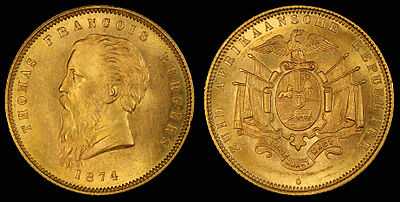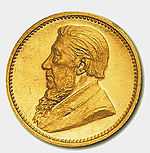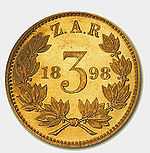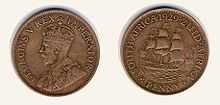Coins of the South African pound
The coins of the South African pound were part of the physical form of South Africa's historical currency, the South African pound. Prior to the Union of 1910, various authorities issued their own pounds, some as independent entities. After the Union but before 1923, coins in circulation were mostly British, but the coins of Paul Kruger's South African Republic remained in circulation. In 1923, South Africa began to issue its own coins adopting a coins that were identical in size and value to those used in Great Britain: 12 pence (12d) = 1 shilling (1s), and 20s = 1 pound (£1). On 14 February 1961 South Africa adopted a decimal currency replacing the pound with the Rand.
The term tickey is applied to both the 3d and 2½c coins.
The Introduction of the Pound
The Cape of Good Hope was a Dutch Colony administered by the Dutch East India Company between 1652 and 1795. In that year it was seized by British forces, returned to the Dutch under the Treaty of Amiens, seized again in 1806 and seceded to Britain under the Anglo-Dutch Treaty of 1814. After the 1806 seizure, the military administrator issued a proclamation prohibiting the export of coinage and fixing the relationship of the various coins in the colony.[1] The relative values were:
| Proclamation by his Excellency Major General Sir David Baird | |||
| Skillings | Stuivers | Sterling | |
| A Guinea | 44 | 264 | £1.2.0 |
| 1 Doubloon, 16 Spanish Dollars | 160 | 960 | 4.0.0 |
| A Johanna, 8 Spanish Dollars | 80 | 480 | 2.0.0 |
| A Venetian Sequin | 19 | 114 | 0.9.6 |
| A Ducat | 19 | 114 | 0.9.6 |
| Gold Mohur, 15 Rupees | 1.17.6 | ||
| A Pagoda | 16 | 96 | 0.8.0 |
| A Spanish Dollar | 10 | 60 | 0.5.0 |
| A Rupee | 5 | 60 | 0.5.0 |
| English Shilling | 2 | 12 | 0.1.0 |
| Copper Coin | 2 | 0.0.2 | |
During the succeeding years, British coins were introduced, but paper Rixdaalers which were nominally worth four English shillings continued to circulate until 1 January 1826 when British currency became the sole legal tender in the Cape Colony[1] and paper Rixdaalers were redeemed at 1s 6½d each.[2]
Nineteenth Century Trade Tokens
The Trade Tokens of Strachan and Company 1874–1932

The Strachan and Co are South Africa's first indigenous currency.[1]
The Strachan and Co trade tokens were issued by a trading store, Strachan and Company in East Griqualand from 1874 onwards and recognised by the Griqua Government.
They were actively used as currency by all the people of the region, white, coloured, Griqua and African. After the territory was annexed by the British in 1878 the tokens continued to be accepted across the region until 1932 when they were outlawed. There are four known issues. The first two the S&Co, and extremely rare S&Co MH set were dated 1874 and used as the region's currency while the two sets issued later were marked "Ïn Goods" reflecting a change in purpose. As imperial coinage became more readily available from the late 19th century these "Ïn Goods" sets were used to barter with the indigenous and Griqua people.
Coins of the South African Republic
The South African Republic (Zuid Afrikaansche Republiek), established under the Sand River Convention of 1852, was one of the two principal 19th century Boer republics. It was later to become the Transvaal, one of the provinces of the Union of South Africa. Although nominally an independent country, it was under British suzerainty apart from the period from 1877 to 1881 when it was under direct British rule. This has led to a debate as to whether its coinage should be classified as being a Commonwealth coinage.
The Burgerspond of 1874

The Burgerspond, struck at Heaton's Mint, Birmingham, England, was the first coin to have been struck for any entity that later became part of South Africa.
In 1853 the South African Republic Volksraad received its first petition for an indigenous coinage. It was not until 1874 that the President of the South African Republic, Thomas Francois Burgers responded to such a request. He sent 300 ounces of gold to J.J. Pratt, the Republic's Consul-General in London with a request that coins, the size of the English sovereign be struck. Pratt contracted with Heatons to strike the coins as requested. Two batches of coins were struck – the first batch of 695 coins begin known as the fine beard type and the second batch of 142 coins being known as the coarse beard type.[1]
When the first issue (the fine beard variety) was presented to members of the Volksraad some scorned the coins that carried Burger's image. The symbolism represented foolish pride to a very religious community, but others supporting him for producing the first coinage for the Republic.[3]
Kruger Coins of 1892–1900
The discovery of gold in the Witwatersrand in 1885 turned the South African Republic from an impoverished state dominated by farmers to one where fortunes could be made from mining. In 1892 President Kruger, facing an election campaign, ordered the building of a mint and the striking of the republic's first full coinage series. The government, which contained a number of Hollanders and Germans, debated whether to base the Republic's coinage on the British coinage or whether to introduce a decimal coinage. Eventually it was decided to adopt the British coinage system as the basis of the Republic's system.[1]
There were 12 pence in one shilling, and 20 shillings in one pond. These coins depict the portrait of the President Kruger. The name of the Republic was Zuid-Afrikaansche Republiek, which was abbreviated on the obverse of the 1d, the 2½s, the 5s, the 1/2 pond, and the 1 pond.
In 1892 the coins that were issued are as follows;
- 1 penny. (Struck in 1893, 1894 and 1898).
- 3 pence or Tickey. (Struck 1893 to 1897).
- 6 pence. (Struck 1893 to 1897).
- 1 shilling. (Struck 1893 to 1897).
- 2 shillings. (Struck 1893 to 1897).
- 2½ shillings. (Struck 1892 to 1897).
- 5 shillings. (Struck in 1892 only).
- 1/2 pond. (Struck 1893 to 1897).
- 1 pond. (Struck through to 1900).
The coins of the 1892 issue were struck at the Royal Prussian Mint in Berlin. The others were struck at the South African Republic's Mint in Pretoria.
There are two types of Kruger coins: Single Shaft and Double Shaft, which is derived from the wagon depicted in the Republic's Coat of arms. The Double Shaft coins are known by the nickname Disselboom, which is Afrikaans for Double Shaft. The 1892 Single Shaft pond coin is a unique coin. The Disselboom coins are the 1892½ pond and 5s coins. One has to be very careful, as there are forgeries of the Disselboom coins, especially the 5s. A genuine Disselboom 5s must have the wheels on the wagon the same size.
The Sammy Marks Tickey of 1898


This very rare coin is the same design as the Tickey of 1892–97, but dated 1898 and struck only in 22 carat (92%) gold. There are 215 pieces known. These were struck by the mining magnate Sammy Marks. There were also contemporary jewellers' copies struck at the same time. The jewellers' copies are also in 22 carat (92%) gold, but they can be identified by the lack of stops in the Z.A.R. monogram at the top of the reverse. The jewellers' copies of the Sammie Marks Tickey are popular with Commonwealth of Nations coin collectors.
The Veld Pond and the Kaal Pond
The Second Anglo-Boer War broke out in October 1899 and in June 1900 the British under Lord Roberts occupied Pretoria, the capital of the South African Republic. When Roberts' entry into Pretoria was imminent, the Boer Government left, taking with them any precious metals at the Pretoria Mint. Amongst the metals were a number of pond blanks that were ready for striking. These were put into circulation and became known as kaal ponde [naked pounds].[1]
The Government set up an emergency mint at Pilgrim's Rest where a total of 986 Veld Ponde were struck and put into circulation. These coins, struck from hand-made dies, had the South African Republic monogram Z.A.R and the date (1902) on the obverse and the text EEN POND on the reverse.[1][4]
Kruger pond brass token
There is a brass token that is often confused with the Kruger 1 pond coin. The giveaway is in the scroll below the Coat of arms. Instead of the normal motto, it is inscribed 'IMITATION KRUGER SOVEREIGN'.
Popularity of the Kruger coins
The Kruger coins are very popular, especially with coin collectors in Scotland. After the Second Boer War, the returning Scots war veterans returned home with pocketfuls of Kruger coins, which they found and souvenired. The 1898 1d often turns up, as it is the most common coin. The 1/2 pond and 1 pond coins are popular, because they are the same fineness as the British 1/2 Sovereign and 1 Sovereign coins: 22 carat (92%) gold.
Coins of the Union of South Africa
From 1923 coins of the Union of South Africa were struck at the Royal Mint, Pretoria. In 1941 the Government of South Africa took over the mint. It was renamed the South African Mint, although it continued to produce coins based on the British coinage for some years thereafter.
King George V first coinage (1923–25/30)
The 2/- was struck under both the first and second coinages of King George V.
- ¼d. Reverse inscribed '¼ Penny ¼': 1923, 1924.
- ½d. Reverse inscribed '½ Penny ½': 1923–1926.
- 1d. Reverse inscribed '1 Penny 1': 1923, 1924.
- 3d. '3' in wreath: 1923–1925.
- 6d. '6' in wreath: 1923, 1924.
- 1/-. Reverse inscribed 'SHILLING': 1923, 1924.
- 2/-. florin: 1923–1930.
- 2/6. Reverse inscribed '2½ SHILLING': 1923–1925.
- ½ sovereign, British type, but with 'SA' mintmark added: 1923SA, 1925SA, 1926SA.
- 1 sovereign, British type, but with 'SA' mintmark added: 1923SA, 1925SA, 1926SA, 1927SA, 1928SA, 1929SA, 1930SA, 1931SA, 1932SA.
King George V second coinage (1925–30)

The reverse of all coins for this era were designed by George Kruger Gray.
King George V third coinage (1931–36)
The previous designs by George Kruger Gray for the reverse of all coins was continued.
King George VI first coinage (1937–47)
The obverse features the uncrowned King George VI design by T. Humphrey Paget. The previous reverse designs by George Kruger Gray for all coins was continued.
King George VI second coinage (1948–50)

The obverse continued the previous design by T. Humphrey Paget and the reverse the previous designs by George Kruger Gray.
King George VI third coinage (1951–52)
The obverse continued the previous design by T. Humphrey Paget and the reverse the previous designs by George Kruger Gray.
Queen Elizabeth II coinage (1953–60)
The obverse features the portrait of Queen Elizabeth II designed by Mary Gillick, while the reverse continued the previous designs by George Kruger Gray.
See also
References
- ↑ 1.0 1.1 1.2 1.3 1.4 1.5 1.6 Rosenthal – From Barter to Barclays – Barclays Bank DCO: undated, c1967
- ↑ Walker, A History of Southern Africa, Longmans: 1968
- ↑ "1874 "Coarse and Fine Beard" Burgers pond". South African coins, token coins & bank notes from van Riebeeck to 1932. Retrieved 2010-12-27.
- ↑ http://www.tokencoins.com/zar11.htm The 1902 Veld Pond – "Pilgrim's Rest Coin" – Retrieved 2009-12-06